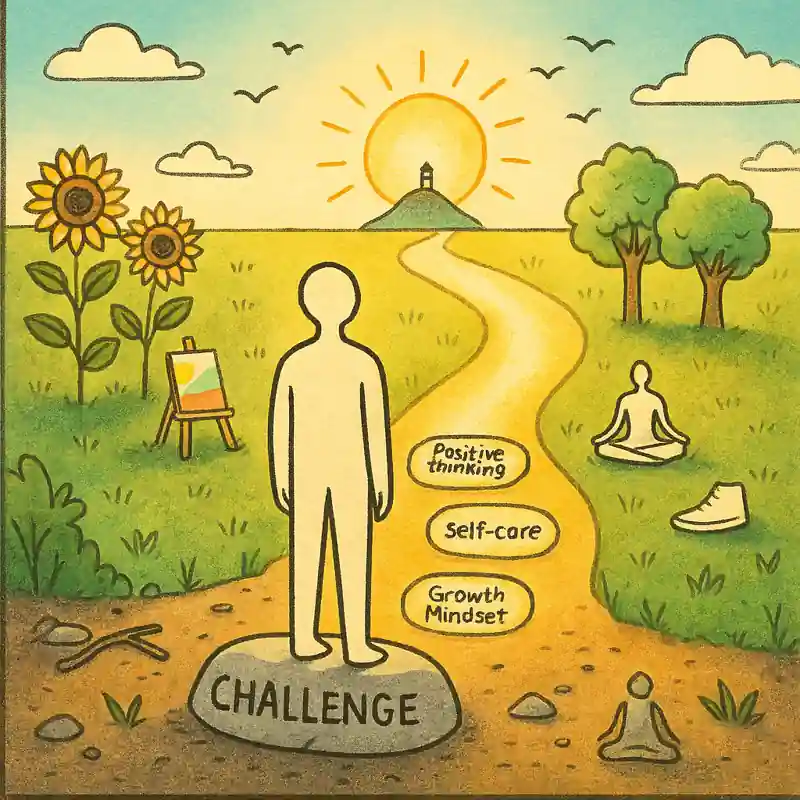In today’s fast-paced and high-pressure world, stress, anxiety, and burnout have quietly become part of everyday life. Between work demands, relationship challenges, uncertainty, and the endless flood of information, it’s easy to feel emotionally drained.
Yet, maintaining a positive and optimistic mindset isn’t just a nice attitude — it’s a powerful form of psychological immunity. Optimism isn’t something you’re born with; it’s a skill that can be developed through awareness, practice, and intention.
This comprehensive guide will walk you through practical and science-backed strategies to help you cultivate a genuinely positive mindset — from reshaping your thinking to building uplifting habits and surrounding yourself with the right environment. By practicing these principles, you’ll gradually strengthen your inner resilience, restore your emotional balance, and rediscover the joy of living with lightness and purpose.

1. Understanding What True Positivity Really Means
Many people think being positive means smiling all the time or pretending everything is fine. But real optimism is not blind cheerfulness — it’s emotional maturity and resilience.
A truly positive mindset includes:
• Realistic Optimism
Optimists don’t deny problems — they acknowledge challenges but still believe in their ability to overcome them. They see obstacles as opportunities to learn and grow rather than reasons to give up.
• Growth Mindset
They believe skills and intelligence can be developed through effort. Failure isn’t the end, but a lesson that moves you closer to success.
• Emotional Regulation
Being able to recognize, accept, and manage emotions — especially negative ones — helps you bounce back faster when life gets tough.
• A Sense of Meaning and Purpose
People who know what matters most to them tend to stay more motivated, hopeful, and grounded even during difficulties.
✨ Science backs it up: Studies show that optimistic people enjoy better mental health, stronger immune systems, lower heart disease risk, and even longer lives — on average, 11–15% longer than pessimists!
2. Seven Practical Ways to Build a Positive and Optimistic Mindset
1. Practice Deep Gratitude: From “Taking for Granted” to “Thankful Living”
Gratitude is one of the simplest yet most powerful tools to boost happiness. It shifts your focus from what’s lacking to what’s abundant.
- Advanced Gratitude Journal:
Don’t just list what went well — reflect on why you’re grateful and what values it reveals (love, kindness, convenience, connection).
Each week, look back on 3–5 moments that made you feel grateful and notice how they shaped your mood and mindset. - Gratitude Letters & Visits:
Write a heartfelt note to someone who’s made a difference in your life — and if possible, read it to them. Research shows this simple act can increase happiness for months. - Tiny Daily Rituals:
Whisper a “thank you” before meals, recall three good things before sleep, or mentally thank the world when you see something beautiful.
2. Take Care of Your Body — Because the Mind Lives There
A strong body nurtures a strong mind.
- Exercise Regularly:
Aim for at least 150 minutes of moderate or 75 minutes of intense activity each week. Exercise releases serotonin and endorphins — your natural mood boosters. - Prioritize Quality Sleep:
7–9 hours a night, with consistent bedtimes. Avoid screens before bed and keep your room dark and quiet. Sleep directly impacts emotional stability. - Eat for Your Mood:
Choose foods rich in Omega-3s (fish, nuts), antioxidants (colorful veggies), and B vitamins (whole grains, beans). A healthy gut means a happier brain! - Mindfulness & Meditation:
Spend 10–15 minutes a day practicing mindful breathing or body scans to calm your thoughts and reconnect with the present.
3. Develop Hobbies That Create “Flow”
Doing what you love isn’t just relaxing — it brings you into the flow state, where time disappears and joy takes over.
- Find the Right Challenge:
Choose activities that balance skill and challenge — painting, writing, gardening, coding, or music. - Set Small Goals:
Break bigger ambitions into smaller milestones. Every step forward builds motivation and confidence. - Join a Community:
Share your passion with others. Positive social energy multiplies your joy.
4. Surround Yourself with Positive People
“You are the average of the five people you spend the most time with.” — Jim Rohn
- Connect with “Energy Givers”:
Spend more time with people who inspire, encourage, and uplift you. Their optimism will rub off naturally. - Protect Your Energy:
Limit exposure to chronic complainers or “emotional vampires.” Set healthy boundaries. - Be the Light for Others:
Offer encouragement, listen with empathy, and share kindness. Helping others is a direct path to happiness.

5. Set Clear Goals and Take Purposeful Action
Direction creates motivation; clarity brings peace.
- Follow the SMART Rule:
Specific, Measurable, Achievable, Relevant, Time-bound. - Break Big Dreams into Small Wins:
Celebrate progress. Every small victory builds momentum. - Enjoy the Process:
Focus on what you’re learning and how you’re growing — not just the final result.
6. Practice Self-Compassion — Be Your Own Best Friend
We often show more kindness to others than to ourselves. Self-compassion means embracing your imperfections with understanding.
- Be Gentle with Yourself:
When things go wrong, talk to yourself as you would to a good friend. - Remember Shared Humanity:
Everyone struggles at times — you’re not alone in imperfection. - Stay Mindful:
Acknowledge emotions without judgment or over-identifying with them.
Try saying:
“This is hard right now, but it’s okay to feel this way. Everyone goes through tough moments — and I believe I’ll get through this too.”
7. Do Good — Expand Your Sense of Purpose
Kindness fuels both happiness and meaning.
- Volunteer:
Join a local community project or charity. Giving back connects you to something bigger than yourself. - Small Acts Count:
Smile, compliment someone, or donate unused items. Even tiny acts of generosity uplift your mood. - Share What You Know:
Mentorship and knowledge-sharing create fulfillment and positive ripple effects.
3. Advanced Mindset Tools: How to Rethink and Reframe
• Cognitive Restructuring
Challenge negative automatic thoughts.
Instead of “I’ll never get this right,” try:
“I didn’t do well this time, but I can learn and improve.”
• The ABC Model (Albert Ellis)
- A: Activating event (e.g., project failure)
- B: Belief (e.g., “I must be perfect”)
- C: Consequence (e.g., frustration, avoidance)
Change B, and C changes too. Replace rigid “musts” with flexible “I’d prefer to.”
• Visualize Your Future Self
Picture your ideal self 5–10 years from now. How would that version of you respond to today’s challenges? Let that vision guide your actions today.
• The “Worst-Case” Technique
Ask yourself: What’s the worst that could happen? How likely is it? What could I do if it did happen? You’ll often realize the fear is smaller than you thought.
4. Daily Positive Habits Checklist
| Time | Habit | Duration |
|---|---|---|
| Morning | Mindful breathing / gratitude meditation | 5–10 min |
| Daytime | Write down 3 good things | 5 min |
| Lunch break | Walk outdoors / listen to uplifting music | 15–30 min |
| Evening | Exercise / pursue a hobby | 30+ min |
| Before bed | Reflect, self-affirm, relax | 10–15 min |
Final Thoughts: Positivity Is a Lifelong Art
Building a positive mindset isn’t about ignoring pain or pretending life is easy — it’s about facing reality with courage and choosing hope anyway.
Every time you express gratitude, show kindness, or stay calm in difficulty, you’re strengthening your mental muscles. Over time, these small, consistent choices create powerful inner resilience.
So start today — pick one practice that speaks to you and take action. Let optimism become the beautiful background color of your life. The more light you choose to see, the brighter your world becomes. 🌞


